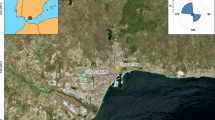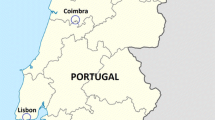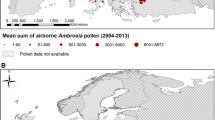Abstract
Aerobiology studies the biological particles suspended in the atmosphere in order to know what types are present in the air and how their concentrations vary spatially or seasonally. The measurement of airborne pollen concentration requires a standardized methodology. Normally, the analysis of the slides obtained after samplings is carried out according to national network procedures. Different networks use different slide counting methods (longitudinal sweeps, transverse sweeps or random fields), and a different number of lines/fields are routinely read. In this study, we compared two slide counting methods adopted by two monitoring centres belonging to different aerobiology networks that operate in southern Europe, the University of Malaga (Spanish Aerobiology Network, the REA) and the University of Roma Tor Vergata (Rete Italiana di Monitoraggio in Aerobiologia, the RIMA). For that, the same samples were counted following the two methodologies consisting on the reading of four (REA) and six (RIMA), respectively, longitudinal sweeps at a magnification of 400X (REA). Statistical analysis was performed in order to search the degree of association between the two series of data obtained, as well as whether or not there were significant differences between them. The results showed highly significant correlation and regression coefficients. On the other hand, Wilcoxon tests, in general, did not showed significant differences between the series for the total pollen as well as for the major pollen types. This confirms that the two methods can be used indistinctly although it would be convenient for the different networks to standardize and unify methodologies in order to follow the same operating procedures.


Similar content being viewed by others
References
Cariñanos, P., Emberlin, J., Galán, C., & Dominguez-Vilches, E. (2000). Comparison of two pollen counting methods of slides from a hisrt type volumetric trap. Aerobiologia, 16, 339–346.
Comtois, P., Alcázar, P., & Neron, D. (1999). Pollen count statistics and its relevance to precision. Aerobiologia, 15, 19–28.
Comtois, P., & Mandrioli, P. (1997). Pollen capture media: a comparative study. Aerobiologia, 13, 149–154.
Felicori, M., Bordignon, G., & Billi, B. M. (2012). Migliora la qualità del monitoraggio aerobiologico. Ecoscienza, 2, 76–77.
Galán, C., Cariñanos, P., Alcázar, P., & Domínguez-Vilches, E. (2007). Spanish Aerobiology Network (REA): Management and quality manual. Córdoba: Servicio de publicaciones, Universidad de Córdoba.
Galán, C., & Domínguez-Vilches, E. (1997). The capture media in aerobiological sampling. Aerobiologia, 13, 155–160.
Galán, C., Smith, M., Thibaudon, M., Frenguelli, G., Oteros, J., Gehrig, R., et al. (2014). Pollen monitoring: minimum requirements and reproducibility of analysis. Aerobiologia, 30, 385–395.
Gottardini, E., Cristofolini, F., Cristofori, A., Vannini, A., & Ferretti, M. (2009). Sampling bias and sampling errors in pollen counting in aerobiological monitoring in Italy. Journal of Environmental Monitoring, 11, 751–755.
Hirst, J. M. (1952). An automatic volumetric spore trap. Annals of Applied Biology, 39, 257–265.
Jäger, S., Mandroli, P., Spieksma, F., Emberlin, J., Hjelmroos, M., Rantio-Lehtimaki, A., et al. (1995). News. Aerobiologia, 11, 69–70.
Käpylä, M., & Penttinen, A. (1981). An evaluation of the microscopical counting methods of the tape in Hirst-Burkard pollen and spore trap. Grana, 20, 131–141.
Mandrioli, P. (1994). Metodica di campionamento e conteggio dei granuli pollinici e delle spore fungine aerodisperse. Monitoraggio aerobiologico in Emilia Romagna. Collana Prevenzione nei luoghi di vita e di lavoro. Contributi (Biblioteca Antonio Panizzi), 30, 9–19.
Mandrioli, P. (1996). Il monitoraggio aerobiologico: linee guida per una standardizzazione. Atti del 15° Congresso Nazionale AIDII, Collane della Fondazione Maugeri, I Documenti n.6, pp 30–41.
Mandrioli, P. (2000). Metodo di campionamento e conteggio dei granuli pollinici e delle spore fungine aerodisperse. Progetto di norma proposto alla Commissione Ambiente UNI dal Dr. Paolo Mandrioli codice progetto ufficiale U53000810. Consiglio Nazionale delle Ricerche—Istituto di Scienze dell’Atmosfera e dell’Oceano.
Micheli, V., Brighetti, M. A., Capucci, E., & Travaglini, A. (2009). Osservazioni sulla superficie minima di lettura nel campionamento aerobiologico. A.I.A. Atti del XII Congresso Nazionale “Salute dell’ambiente salute dell’uomo”. Firenze 7-9 maggio 2009.
Onorari, M., Domeneghetti, M. P., & Begliomini, V. (2007). Metodo UNI 11108:2004—Percorso per l’accreditamento. Gea, 3, 33–34.
Oteros, J., Galán, C., Alcázar, P., & Domínguez-Vilches, E. (2013). Quality control in bio-monitoring networks, Spanish Aerobiology Network. Science of the Total Environment, 443, 559–565.
Thibaudon, M., Monnier, S., & Berger, U. (2014). Standardization of Hirst method for airborne pollen and fungal spores measurements. “Meeting of the European Aeroallergen Network and the European Aerobiology Society”. Viena; p. 47.
Travaglini, A., Albertini, R., & Zieger, E. (2009). Manuale di gestione e qualità della Rete Italiana di Monitoraggio in Aerobioloiga R.I.M.A.®. Tipografia LEGO, Bologna, p.147.
Travaglini, A., Brighetti, M.A., Arsieni, A., & Vinciguerra, F. (2014). Atlante del polline delle principali specie allergeniche d’Italia. Il raggio verde edizioni. ISBN: 978-88-89663-79-0.
UNI Ente Nazionale Italiano di Unificazione. (2004). Qualità dell’Aria metodo di campionamento e Conteggio dei granuli pollinici e delle spore fungine aerodisperse. Classificazione ICS, 13(040), 20.
Zieger, E. (2007). Linee guida e accreditamento in Aerobiologia. Gea, 3(1), 32–33.
Author information
Authors and Affiliations
Corresponding author
Rights and permissions
About this article
Cite this article
Gharbi, D., Brighetti, M.A., Travaglini, A. et al. Comparison between the counting methods used by two aerobiology networks in southern Europe (Spain and Italy). Aerobiologia 33, 87–92 (2017). https://doi.org/10.1007/s10453-016-9452-4
Received:
Accepted:
Published:
Issue Date:
DOI: https://doi.org/10.1007/s10453-016-9452-4




